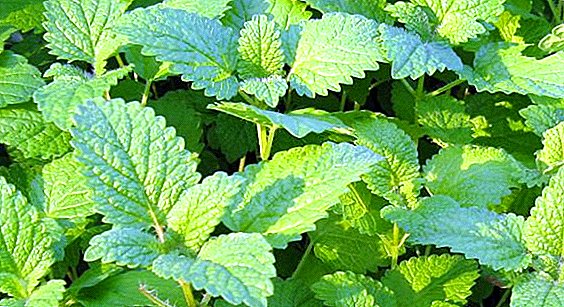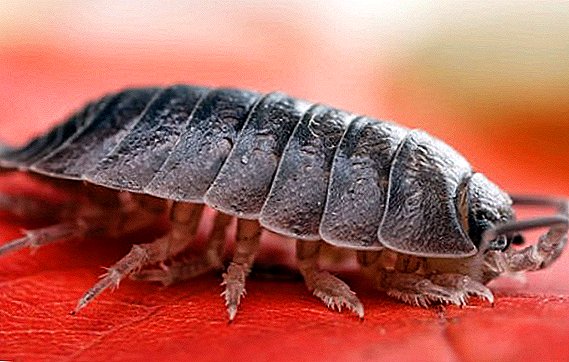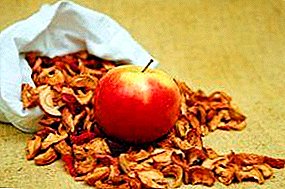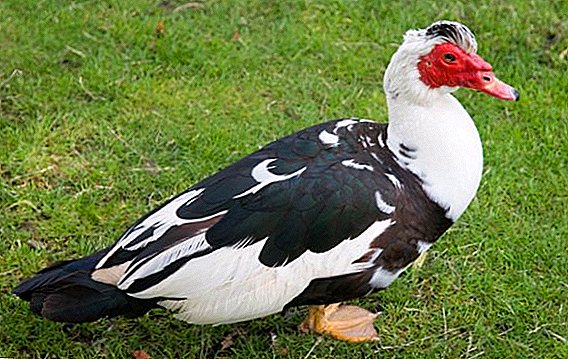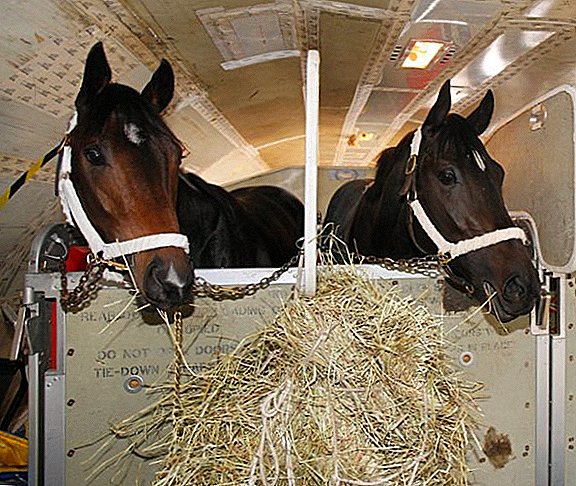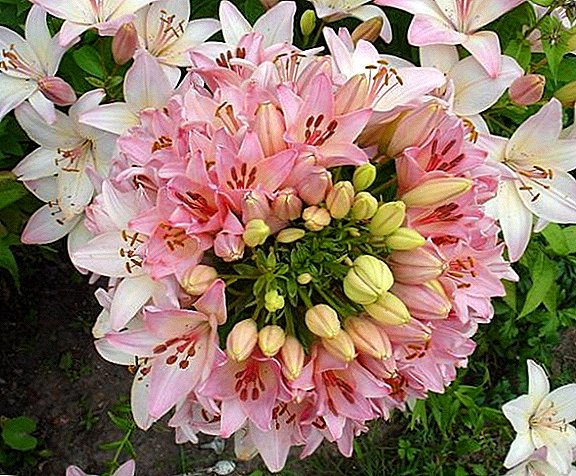 With the advent of autumn, the plot is added - you need to have time to harvest the crop, and prepare trees for plants for the winter. Here comes the question of the autumn planting of lilies. Some growers recommend waiting with this process until spring, however, the autumn planting has many advantages: the bulb can surely take root during the winter, which means the plant will be strong, healthy and will give color earlier. How to organize the transfer of lilies in the autumn season?
With the advent of autumn, the plot is added - you need to have time to harvest the crop, and prepare trees for plants for the winter. Here comes the question of the autumn planting of lilies. Some growers recommend waiting with this process until spring, however, the autumn planting has many advantages: the bulb can surely take root during the winter, which means the plant will be strong, healthy and will give color earlier. How to organize the transfer of lilies in the autumn season?
Landing features

Although lilies belong to perennial plants, for most varieties the period of productivity when grown at the same place is an average of 3 years, for some varieties it is 5 years. But the American plant varieties, which do not differ in rapid growth, can "live" on one site for up to 10 years. After that, the flowers need a transplant with a nest split, otherwise the bulb grows and it lacks food and space.
Important! The planting period is very important: if the bulbs are planted at too high a temperature, they will germinate and die, but in frozen soil they will not be able to safely winter, as the root system will not be able to adapt and grow strong.
Planting lilies for the winter has both its advantages and weaknesses, which must be taken into account:
| Merits | disadvantages |
| Bulbs after flowering are immersed in a period of rest, which means that the risk of damaging them is minimal. | If the winter is extremely frosty and long, there is a small chance that the transplanted bulbs may not withstand such conditions and die. |
| During the spring-summer season, onions are recruited nutrients. | The onions dug out in the fall cannot be stored for a long time. |
| When planting in autumn, the lily will bloom earlier. | Transplanted onions need quality insulation for the winter. |
| Plants will become resistant to late spring frosts. | Rodents can attack transplanted flowers. |
| Will be able to get more babies. | |
| Onions will have time to adapt to the new soil. | |
| Autumn transplanting is suitable for most varieties. |
Did you know? According to the ancient Greek myth, lilies appeared on earth from the milk of the main goddess Hera, who wanted to give them water to little Hercules. However, the milk spilled across the sky, creating the Milky Way, and from a few drops that fell to the ground, wonderful snow-white flowers with a wondrous aroma grew.
What is the timing
It is very important not to miscalculate in the fall with planting dates of lilies. The period favorable for transplanting is determined by weather conditions, climatic features in a particular region and, of course, requirements for weather conditions for different varieties of lilies.

From the region
Lily transplantation may begin in the second half of August and sometimes continue until the beginning of November, but more precise planting dates are determined by climatic conditions. features of the region:
- Siberia. In this area, transplantation is best done in September.
- Ural The first month of autumn and even the first weeks of October are suitable for this area (provided that they are warm).
- Moscow region. The end of August-beginning of September is considered the best period for transplanting flowers.
- Middle band. The best period is early autumn: the end of September and the beginning of October.
- Ukraine. Due to the warm climate, transplants can be carried out from October to November.
From the weather

It is best to focus on the average daily temperature - if the mark on the thermometer does not rise above 10-12 ° C, then the optimal time has come for the transplantation of flowers. Choose a dry, windless, fine day. Consider that at lower temperatures the root part of the plant develops well and survives, and at higher temperatures the stem will develop better. Therefore, it is important to “catch” the optimum temperature for planting - it will depend on this whether the plant will take root or not.
Important! If the bulb has sprouted, it is impossible to leave it in the open ground for the winter - the plant will die! Lily needs to be carefully dug, transplanted into a pot and left to winter in an apartment (house). Sprouted lilies can be planted in the ground no earlier than May.
From the view
If you do not know when to dig lilies for transplanting in the fall, decide on the varieties for which you want to change places. The transplant period is determined by the characteristics of each class: the period of flowering, the onset of peace, etc.
- First you need to "change the place of residence" for all varieties and hybrids of the White Lily.
- Then you can begin to transplant Candide variety lilies - the dormant period for these varieties begins in the second half of August.
- In the first half of October, you can begin to replant the Tubular and Eastern varieties.

Rules for transplanting lilies in autumn
As soon as suitable weather conditions come for your region, you should start the transplant process soon. To do this, you need to select the best planting material, select and prepare a landing site. Proper care of transplanted onions is the key to a successful wintering and good growth in the spring.
Learn more about lily varieties such as Kinky, Marlene, brindle
What bulbs fit
Do not take for the autumn planting imported material imported from Holland - the flowers of this region may be poorly adapted to our climatic conditions, so they are much worse tolerate winter frosts. It is best to use bulbs from your site. If you want to breed a new variety, buy onions and proven familiar flower growers or in specialized stores. However, make sure that the bulbs are suitable for the climate of your territory.

Make sure that the onion is fresh, i.e., dug up shortly before the sale, because there are often cases that in the beginning of autumn unscrupulous sellers offer very low prices for planting material that has not been bought since spring. Such bulbs will be very weak, painful or even die.
Did you know? The “Golden Lily” in China was called the bandaging of women's feet. At the same time, the foot acquired a hoof-like appearance, it became very small compared to a normal leg, which made the woman change her gait and posture while walking for balance. The movements of women's hands with a similar walk were associated by the Chinese with an exquisite lily flower.
Also check the bulbs for seedlings - they should not be. The only exception here is the Candida lily. This species should overwinter by sprouting green bush.
State of planting material
Select only the best bulbs for planting:

- they should not have traces of rot, spots, tainted areas;
- Onions should be large, dense, without soft areas.
In the preparation of planting material, adhere to the following rules:
- Carefully cut the stems at a distance of 5-10 cm to the ground.
- Using a pitchfork in order not to disturb the root system, dig a flower.
- Peel the flower from the ground, remove dry parts, excess scales, roots.
- Be sure to disinfect the bulbs in a solution of potassium permanganate, or with drugs Fundazol, Karbofos or Benomil. Keep the plant in solution for at least half an hour.
- Let the onions dry in the shade during the day. Do not leave planting material in direct sunlight, otherwise it may dry out.
Site selection and soil requirements
Consider in advance where you will replant your favorites. It is known that lilies are quite demanding on the soil and terrain, so you need as close as possible to the natural conditions.

- Illumination. So, it is best to choose a sun-protected plot. It should warm up well on summer days. If the lilies grow in a small shade, they will bloom later, but the flowers in this case will please the eye longer, and the plant itself will not fade and dry in the sun. Best of all, if the sun will fall on the plants in the morning.
- Drainage. Be sure to make good drainage and runoff, it should not linger on the area with lilies after the spring thaw or heavy rains. In such conditions, lilies quickly rot.
- Ph level Most lilies grow well in a neutral environment, but here you should take into account the characteristics of each variety: American, Oriental and Asian species love a slightly acidic soil, but for example, Tubular and Candide lilies feel better in a slightly alkaline environment. If you need to change the acidity of the soil, use peat and ash: first acidify it, and ashes alkaline.
- The composition and characteristics of the soil. It should not be heavy, with the predominance of clay. On the contrary, lilies will grow well in loose soil with the addition of sand and peat.
The size of the well will depend on the type of plant:

- Low-growing species are planted at a depth of 7-12 cm, depending on the size of the onion. Between the bushes need to keep a distance of at least 15 cm.
- Sredneroslye varieties. The ideal planting depth is 10-15 cm, and the distance between the bushes increases to 25 cm.
- Tall varieties of flowers need to be deepened by 12-20 cm, depending on the size of the bulb, and keep the distance between lilies up to 30 cm.
Important! It is better to plant a bulb a little deeper - this is how it will take root and give more children, although the period of its germination will be somewhat longer. But if you plant a shallow bulb, as it grows, it will sink a little to the depth it needs. Remember that the smaller the bulb, the smaller the groove, and vice versa.
Regarding fertilizers, here every gardener has his own tips and principles. Some recommend not to add organic fertilizer to avoid putrid diseases. But others do not represent landing without adding humus or manure. To improve the composition of the soil, you can resort to such mineral additives: superphosphate and potassium sulfate.
Transplant technology
Before transplanting, the soil needs to be dug up half a meter, if it is too heavy, add peat and sand, adjust the acidity if necessary. It is best for lilies to build bulk beds with fencing.
Learn more about such representatives of the Liliaceae family: tulips, hionodoksa, imperial grouse, kupena and kandyk.
Further, the procedure is as follows:

- It is necessary to make holes with depth and with the necessary distance between the grooves.
- Put a drainage layer on the bottom (maybe sand).
- Spread onion roots along the bottom of the hole, sprinkle a little sand.
- Cover the onion with the primer so that its neck stays at ground level.
- Planted plants need to be watered with warm water and mulched with a layer of compost, sawdust, pine needles, bark. This will not only allow the soil to retain moisture longer, but also serve as a good shelter in the winter frost.
Did you know? On the island of Sumatra a very unusual plant grows - “Deadly Lily”, however it has nothing in common with the ordinary lily that we grow at home. This huge parasitic plant, with a flower weight of up to 10 kg and a diameter of up to 2 m, lives on lianas and trees, the real name is rafflesia. The nickname of the plant appeared due to the foul smell of carrion. Rafflesia is considered the largest flower in the world.
Lily transplantation in the fall to another place is used by many experienced gardeners instead of a spring procedure. It does not matter if you use your material or purchased onions, if you follow the simple technology, you can easily and quickly plant lilies, and enjoy beautiful flowers next season. If you are not yet a fan of these plants, it's time to try growing them!



